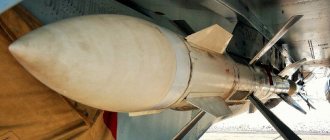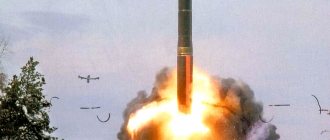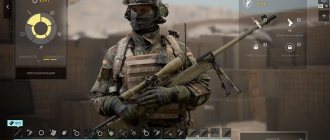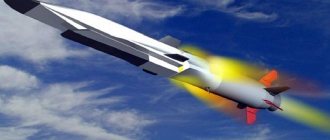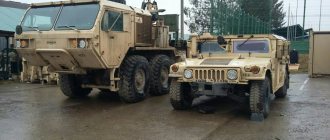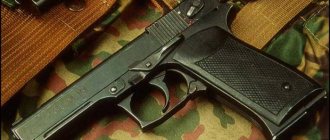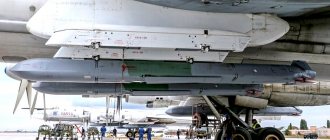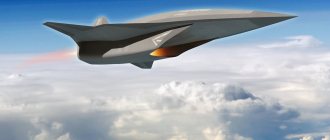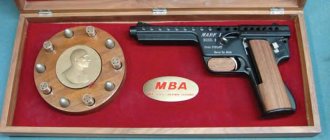BGM-109 "Tomahawk":
Home » Alternative aviation » BGM-109 “Tomahawk”:
Alternative aviationLittle-known and unrealized projects of aircraft and other flying equipment
admin 05/26/2012 134
0
in Favoritesin Favoritesfrom Favorites 0
The BGM-109 Tomahawk cruise missile has long become something more than a weapon. And even more than a symbol of the American war machine. In modern thinking, the Tomahawk is a symbol of non-contact warfare - a revolution in military affairs comparable in scale only to the advent of the blitzkrieg in the mid-20th century.
Origin
...Vietnam turned out to be a good lesson for the American Air Force. He clearly demonstrated that in the context of the rapid development of air defense systems, the previous priorities of aviation - speed and altitude - are no longer reliable protection. To hide from the attack of anti-aircraft missiles, aviation was forced to hug the ground, fly as low as possible - leaving the effective detection and tracking radius of radars.
Back in 1971, the US Navy began developing a new generation cruise missile to be launched from submarines against coastal targets. The missile was supposed to be launched either through Polaris silos (the so-called “heavy” version) or through the tubes of torpedo tubes (the “light” version). It was noteworthy that from the very beginning the new missile was positioned as adaptable to existing launchers - the American fleet was not yet very confident in its approach, which ultimately turned out to be correct.
In 1972, for budgetary reasons (and due to reluctance to use SSBNs for tactical purposes), the “light” version was chosen and received a government contract to develop a new projectile. LTV received a similar contract for regular insurance.
Codenamed SLCM - Submarine-Launched Cruise Missile - the future Tomahawk entered development.
From the very beginning, under the influence of the Vietnam War, it was decided to take the most radical step away from previous American cruise missile designs. The basis for a breakthrough to the target for the Tomahawk was to be a passage at a very low altitude - in fact, less than 50 meters above the ground. It is quite natural that at such a low altitude it was simply impossible to make the rocket supersonic, and therefore it was decided that the future cruise missile would fly at only 0.8 the speed of sound. Gone are the cruise missiles, rushing to the target at 2-3 Mach at an altitude of 15-18 kilometers - the basis of the tactics of the new missile was supposed to be covert penetration.
In 1974, both developers presented their missiles - the YBGM-109A from General Dynamics and the YBGM-110A from LTV.
In a dispute for superiority, YBGM-109A and YBGM-110A take off from under water.
As a result of the competition, the YBGM-109A from General Dynamics showed the best combat qualities, and was chosen as the basis for the creation of a new missile. Flight tests - including tests of the key TERCOM system for the program - the radar "surface control" system - began already in 1975. At the same time, it was decided that the future SLCM would be launched from surface ships, and the letter S in its name began to be read as Ship .
In 1977, the US government made another of many (mostly unsuccessful) attempts to combine the Navy and Air Force development programs into one. The Navy has proposed merging the SLCM program with the AGM-86 ALCM aircraft program, which has been running since 1968. As part of the proposal, the Navy half-heartedly proposed a prototype of the AGM-109 ALCM missile, but the project did not receive support from the Air Force and the "domestic" Air Force AGM-86 ALCM missile was declared the winner of the competition. The only common thing in the programs was the use of the TERCOM system for low-altitude flight control.
Work on the Tomahawk continued. In March 1980, the first production missile was launched from the destroyer Merrill. In June of the same year, the underwater version, UGM-109, was also tested. Evaluation of the project and its refinement continued for almost two more years after the start of large-scale production, and only in 1983 the Tomahawk system was officially announced for service.
Design
The original Tomahawk was a fairly simple rocket projectile of a utilitarian form.
The cylindrical body of the projectile was equipped with two short folding wings, a cross-shaped tail, with the only protruding part - the air intake under the body. It was driven by the highly economical Williams WR-400 (on later versions - the WR-402 with more power). The projectile was launched using a solid fuel jettisonable accelerator that burns out in 12 seconds.
The basis of the Tomahawk project was its guidance system.
In the original versions, the missile used a high-performance inertial guidance system combined with the TERCOM system. The TERCOM radar emitted a narrow beam aimed at the ground directly below the missile. Studying the reflected signals, the rocket's computer compared them with a satellite radar map stored in memory, captured in advance, and guided the rocket exactly along it.
Later Tomahawk models were equipped, to improve accuracy, with a GPS system that used navigation satellites to determine the missile's position. It should be SPECIALLY noted that GPS beacons are used only by some rocket modifications, and always only as an addition to the inertial guidance system and the TERCOM system. Therefore, rumors about the possibility of knocking the Tomahawk off course by jamming the GPS signal are elementary disinformation (most likely made by the Americans themselves) - in this case, the missile simply excludes GPS from control and follows the INS and TERCOM signals.
In the final guidance phase, missiles, starting with the BGM-109C modification, used the DSMAC optical-electronic guidance system, which can effectively recognize objects against the background of the terrain. It is its use that provides the Tomahawk with a QUO in the region of 5-10 meters.
Modifications
All modifications of the Tomahawk (including one) had two sub-models - for surface ships, designated RGM, and for submarines, UGM. The official designation of the rocket was BGM-109.
The BGM-109A with a nuclear warhead was the first production modification of the Tomahawk to enter service. It carried the W-80 thermonuclear warhead, with a yield of up to 200 kt, and was intended to ensure the fleet’s ability to launch operational tactical and strategic nuclear strikes with a reaction speed exceeding the capabilities of carrier-based aircraft. The Eo was also the longest-range modification - its range was 2500 km.
In parallel, the US Navy developed a version of the BGM-109B TASM intended for use in the role of anti-ship missiles. Unlike the basic version, the missile had a shorter range (about 500 km), due to which it was equipped with a powerful radar homing head and a 450-kilogram semi-armor-piercing warhead. It was intended to “support” the Harpoon as a long-range weapon. The missile was also trained to perform a number of evasive maneuvers (mostly jumps), and a sharp jump to attack a target from above.
A Tomahawk without a warhead hits a target ship in January 1981 at a distance of almost 500 km. Until recently, only Russians could do this...
The BGM-109C appeared in 1986 as a conventional version of the Tomahawk for tactical purposes. After reviewing the Tomahawk test results, the Navy believed that they were an ideal weapon for destroying ground targets - if equipped with a precision targeting system at the final site.
Actually, it was the BGM-109C that became “the Tomahawk” that we imagine today.
Already the first modifications of the BGM-109C demonstrated impressive results - at a range of up to 1250 km, the accuracy of the missile was about 10 meters! The first modification of the missile, Block IIA, had only one attack mode - the missile approached the target at low level and attacked it from the side. Subsequently, new modifications of the missile learned to attack a target in a dive, which significantly increased its effectiveness. The conventional impact detonator on these models was replaced with a programmable detonator, which detonated the missile precisely as it flew over the target.
In 1988, another modification appeared - BGM-109D. This version of the missile was created to destroy area targets and concentrations of enemy troops. Instead of one warhead, the missile carried a cluster warhead of 168 submunitions. Flying over positions, the missile could effectively disperse its bomb payload, much better suited for killing troops than conventional heavy warheads.
Two more modifications - BGM-109E and BGM-109F - never saw the battlefield. The first of them was supposed to be an improved anti-ship missile, the second - a special “anti-airfield” missile with a partially penetrating cluster warhead.
The final - currently most advanced - version of the missile was the BGM-109E “Tactical Tomahawk”. The missile was created for effective use as a tactical support weapon for troops. Its control system was supplemented with a communication channel, allowing the rocket autopilot to be reprogrammed in flight and redirected to any of 15 possible alternatives. The rocket also had a video camera to broadcast data in flight.
In 2002, the BGM-109E entered service.
A modification of the BGM-109E is the BGM-109H , a version designed specifically to engage protected targets. It carries a penetrating warhead.
"Griffin" - ground-based "Tomahawk"
The wide capabilities of the Tomahawk attracted the attention of the army. The military was looking for a way to replace the retired MGM-13 MACE, and the new missile caught their attention.
The first launch of the BGM-109G Griffon rocket took place in 1980.
Structurally, the missile was no different from the naval Model A, except that it carried the nuclear W-84. It was launched from a 4-charge launch container.
Together with the Pershing II, the army's Tomahawks fended off the new USSR Pioneer MRBM. Although the missile launchers could not boast such efficiency as MRBMs, they were much less noticeable in flight, and - taking into account the situation in the development of air defense systems in the 1980s - they could easily sneak past the main Soviet air defense systems unnoticed.
More than 500 missiles were deployed in Europe when the parties signed a nuclear weapons limitation agreement in 1988. A special point on the part of the USSR was the decommissioning of all nuclear Tomahawks from service - this point was considered key by the Soviet commission.
All BGM-109 missiles were withdrawn from service in 1991.
Launchers
A distinctive feature of the Tomahawk was its undemanding launchers. It could run:
- from 533 mm TA submarines
- with a specially designed 4-round Armored Box Launcher
— From UVP Mk-41
ABL deserves special attention. This 4-charge launcher was massively installed on all US Navy ships in the 1980s, along with Harpoon missile launchers. Even destroyers received 8 Tomahawk missiles!
This is exactly what the launchers were equipped with - 8 pieces for each, i.e. 32 missiles - battleships "Iowa" after modernization in 1980.
The program to equip the US Navy with Harpoon and Tomahawk missiles can easily be called unique and has no analogues. At the cost of relatively small costs, by installing “Harpoons” and “Tomahawks” on existing ships, the striking power of the US fleet more than doubled in the shortest possible time! It was not for nothing that the situation was called in the 1980s “the nightmare of Soviet admirals,” who urgently began developing the Granat missile, similar to the Tomahawk, in order to urgently counter the American advantage.
Combat use
Tomahawk missiles have been a symbol of the American idea of proximity warfare since their first use in 1991 in Iraq. Then 261 TLAM-C and 27 TLAM-D missiles were fired from ships and submarines. The success rate was 85%!
The missiles were later used in Iraq, put an effective end to Yugoslavia, and destroyed enemy camps in Afghanistan. Their last successful debut was Libya - where more than 140 missiles were fired from the underwater monitor of the USS Florida - a converted Ohio series missile carrier, carrying 144 (!!!) Tomahawk missile launchers instead of ICBMs.
"Tomahawk" has become, in a way, a symbol of a new generation of war - a war of machines, in which people only give orders.
"Tomahawk" - "smart" weapon
But the main distinguishing feature of the Tomahawks is not these wings, but the complex of systems that control them.
It is the “smart” filling that allows the rocket to remain in the air and literally circle within the radius of destruction of a given target until the remote operator sends it a command to detonate. The missile can remember up to fifteen targets, with a detailed indication of the coordinates and detailed characteristics of each. This feature allows you to instantly redirect the Tomahawks to another mark if, for some reason, the original target is unsuitable for attack.
The Tactical Command System or "TTWCS" is responsible for managing this function.
In addition to it, there are also other complex systems on board the missile, which ensure precise hit accuracy and the most responsive control of the Tomahawk.
Let's talk about each of these systems in more detail.
"GPS"
Everyone knows what it is. For the Tomahawk, this is the main coordination system, since the location of the target is primarily known to the missile via GPS coordinates. In addition, thanks to GPS, the rocket updates its flight path and changes it if necessary.
"INS"
This system acts as an auxiliary system for other systems, or coordinates missile guidance if GPS and TERCOM-DSMAC are blocked for some reason. It includes a gyroscope and an accelerometer, the readings of which allow you to calculate the direction and required speed to hit the target.
"TERCOM-DSMAC"
The most interesting system is the Tomahawk, consisting of two subsystems. TERCOM uses data from the radar altimeter and compares it with existing terrain information. DSMAC does similar work, but uses satellite photos.
Together, these two systems create an extremely strong symbiosis, allowing not only to coordinate the flight of a missile, but also to carry it out at the lowest possible altitude, in an area inaccessible to radar.
"Tomahawk" - past and present
In total, over the entire history of the Tomahawks, 7 varieties of these missiles were developed. Some of them were removed from service several decades ago. For example, such a fate befell complexes that were launched from the ground.
Interestingly, in the past, the route of the first models had to be plotted a week before the date of the planned attack using aerial mapping made from an airplane. During the launch, one could only hope that the tactical situation had not changed during this time.
The technical development of this rocket model does not stand still. Thus, in 2020, the Los Alamos National Laboratory presented a development that would further increase the combat power of the Tomahawk using unburned fuel.
Also, the establishment of production of these missiles made it possible to reduce the cost to 650 thousand dollars, instead of 1.5 million in the past.
Coupled with its versatility in performing combat missions, the Tomahawk can easily be called one of the most impressive military developments in recent years.
Tomahawk engine
Now we should say a few words about the Tomahawk engine, because it is responsible for such a long flight over a long distance. The missile is equipped with an F107-WR-402 turbofan engine. Although it cannot be called the fastest, it still provides stable flight at a good speed.
By the way, if necessary, the rocket engine can be equipped with a special rocket booster, which, after use, is reset like the stages of a launch vehicle.
What about the warhead, you ask? Since the Tomahawk is essentially a modular missile, its warhead can carry both a nuclear charge and conventional explosive components.
For example, it could be 450 kilograms of explosive.
Or cluster bombs, if there is a need to destroy a heavily armored target.
Media (As of 2008)
- 31 Los Angeles-class nuclear submarines, up to 12 cruise missiles;
- 4 Ohio-class nuclear submarines, 154 cruise ships each;
- 3 Seawolf-class nuclear submarines, up to 50 cruise missiles;
- 3 Virginia-class nuclear submarines, up to 12 cruise missiles;
- British attack nuclear submarine "Astyut" (2007, the first of four of this class), displacement 7200/7800 tons, service life ~ 30 years, 6 torpedo launchers, 38 missile launchers;
- Arleigh
Burke-class destroyers are in service and 8 more are being built at the Brunswick and Pascagoula shipyards, armament 90/96 KR (depending on the series of the ship); - 22 missile cruisers of the Ticonderoga class, in the standard version - 26 missile cruisers;
- starting in 2013, the launch of 2 new destroyers of the DDG-1000 series with 80 missiles each
military equipment
TLAM-D contains 166 submunitions in 24 canisters: 22 canisters of seven each, and two canisters of six each to fit the dimensions of the airframe. The submunitions are the same type of combined effects bomb munitions used in large quantities by the US Air Force with the TsB-87 Combined Effects Munition. In submunitions, the canister dispenses two at a time, one on each side. The missile can carry up to five separate target segments, allowing it to attack multiple targets. However, in order to achieve sufficient coating density, as a rule, all 24 canisters are poured sequentially from the back to the front.
navigation
TERCOM – Relief contour Matching. A digital representation of the terrain area is displayed based on digital terrain data or stereo images. This map is then inserted into the TLAM mission, which is then mapped onto the rocket. When the rocket is in flight it compares the stored map data with radio altimeter data collected as the rocket flies over the map. Based on the comparison results, the rocket's inertial navigation system is updated and the rocket adjusts its course. TERCOM was based on, and is a significant improvement on, the "fingerprint" technology developed in 1964 for SLAM.
DSMAC – Digital Scene Matching Zone Correlation. A digitized image of the area is displayed and then integrated into the TLAM mission. During the flight, the rocket will check that the images it has accumulated correlate with the image it sees below it. Based on the comparison results, the rocket's inertial navigation system is updated and the rocket adjusts its course.
Options
There were several variants of the BGM-109 Tomahawk, using different types of warheads.
- BGM-109A Tomahawk Land Attack Missile – Nuclear (TLAM-N) with W80 thermonuclear weapon. Retired from service sometime between 2010 and 2013. Reports from an early state in 2020 that the US Navy was considering (re)introducing a (yet unknown type) nuclear-tipped cruise missile into service.
- RGM/UGM-109B Tomahawk Anti-ship Missile (TAS-M) – active guidance radar anti-ship missile version; decommissioned in 1994 and converted to Block IV version.
- BGM-109C Tomahawk Land Attack Missile - Conventional (TLAM-C) with a unitary warhead. It was originally a modified bullpup warhead.
- BGM-109D Tomahawk Land Attack Missile – Dispenser (TLAM-D) with cluster munitions.
- RGM / UGM-109E Tomahawk Site Attack Missile (TLAM Block IV) - an improved version of the TLAM-C.
- BGM-109G Ground cruise missile (GLCM) – with W84 nuclear warhead; decommissioned in 1991 to comply with the INF Treaty.
- AGM-109H/L Medium-Range Air to Surface Missile (MRASM) – a shorter range, turbojet-powered air cruise missile with cluster munitions; not commissioned, cost US$569,000 (1999).
Land-based cruise missiles (GLCMs) and their cargo-type launch vehicles have been used at bases in Europe; they were retired in accordance with the 1987 Intermediate-Range Nuclear Forces Treaty. Many of the anti-ship missile versions were converted to TLAMs at the end of the Cold War. Block III TLAMs, which entered service in 1993, can fly 3 percent further using their new turbofan engines and the use of global positioning system (GPS) receivers to hit more accurately. Block III TLAM-Cs retain Digital Scene Matching Area Correlation System (DSMAC) II, allowing GPS only missions that allow for rapid mission planning, with some reduction in accuracy, DSMAC only missions that take longer to plan but terminal accuracy Somewhat better are GPS-automated missions, which combine both DSMAC II and GPS navigation, which provides the greatest accuracy. Block IV TLAMs have an improved turbofan engine allowing for throttle control, allowing in-flight speed changes, as well as better fuel economy and faster startup times. Block IV TLAMs have advanced lingering capabilities and are equipped with real-time guidance systems to engage fleeing targets, as well as on-board electro-optical sensors allowing real-time assessment of battle damage. In addition, the Block IV missile has the ability to be retargeted and the ability to transmit, via Satcom, an image immediately prior to impact to assist in determining if the missile was attacking a target and the likely damage from the attack.
